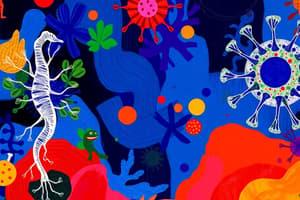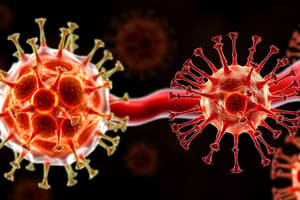Podcast
Questions and Answers
Which of the following is NOT a component of innate immunity?
Which of the following is NOT a component of innate immunity?
- Memory B cells (correct)
- Physical barriers
- Phagocytes
- Complement system
The process by which T cells learn to distinguish self from non-self antigens in the thymus is called:
The process by which T cells learn to distinguish self from non-self antigens in the thymus is called:
- Adaptive immunity
- Clonal selection
- Thymic education (correct)
- Antigen presentation
Which type of immune cell is primarily responsible for antibody production?
Which type of immune cell is primarily responsible for antibody production?
- T helper cells
- Macrophages
- B lymphocytes (correct)
- Cytotoxic T cells
What is the main function of Major Histocompatibility Complex (MHC) II molecules?
What is the main function of Major Histocompatibility Complex (MHC) II molecules?
Which of the following is NOT a characteristic of adaptive immunity?
Which of the following is NOT a characteristic of adaptive immunity?
Neutrophils are primarily involved in:
Neutrophils are primarily involved in:
The process by which lymphocytes capable of responding to a specific antigen proliferate is called:
The process by which lymphocytes capable of responding to a specific antigen proliferate is called:
Which of the following is NOT a type of professional antigen-presenting cell?
Which of the following is NOT a type of professional antigen-presenting cell?
The primary function of helper T cells is to:
The primary function of helper T cells is to:
Which of the following best describes the function of cytotoxic T cells?
Which of the following best describes the function of cytotoxic T cells?
The ability of the immune system to respond more quickly and effectively to a pathogen it has encountered before is due to:
The ability of the immune system to respond more quickly and effectively to a pathogen it has encountered before is due to:
Which of the following is NOT a function of the lymphatic system?
Which of the following is NOT a function of the lymphatic system?
Interferons are classified as:
Interferons are classified as:
Which of the following cells does NOT perform phagocytosis?
Which of the following cells does NOT perform phagocytosis?
The type of immunity obtained during a lifetime is called:
The type of immunity obtained during a lifetime is called:
Which of the following is an example of a recombinant vaccine?
Which of the following is an example of a recombinant vaccine?
IgM antibodies are primarily:
IgM antibodies are primarily:
Monocytes differentiate into:
Monocytes differentiate into:
Which of the following is NOT a characteristic of IgG antibodies?
Which of the following is NOT a characteristic of IgG antibodies?
The process of diapedesis refers to:
The process of diapedesis refers to:
Which of the following is NOT a function of the complement system?
Which of the following is NOT a function of the complement system?
The theory of clonal selection states that:
The theory of clonal selection states that:
Which of the following is NOT a characteristic of a good vaccine?
Which of the following is NOT a characteristic of a good vaccine?
The process by which macrophages engulf and destroy pathogens is called:
The process by which macrophages engulf and destroy pathogens is called:
Which of the following is NOT a function of antibodies?
Which of the following is NOT a function of antibodies?
The primary site of T cell maturation is:
The primary site of T cell maturation is:
Which of the following best describes the function of regulatory T cells?
Which of the following best describes the function of regulatory T cells?
The process of somatic hypermutation occurs in:
The process of somatic hypermutation occurs in:
Which of the following is NOT a characteristic of a secondary immune response?
Which of the following is NOT a characteristic of a secondary immune response?
The main function of the spleen in the immune system is:
The main function of the spleen in the immune system is:
Which of the following is NOT a function of dendritic cells?
Which of the following is NOT a function of dendritic cells?
The process by which B cells undergo class switching to produce different antibody isotypes is called:
The process by which B cells undergo class switching to produce different antibody isotypes is called:
Which of the following is NOT a characteristic of innate immunity?
Which of the following is NOT a characteristic of innate immunity?
The main function of natural killer (NK) cells is:
The main function of natural killer (NK) cells is:
Which of the following is NOT a type of hypersensitivity reaction?
Which of the following is NOT a type of hypersensitivity reaction?
The process by which antigens are broken down into peptides for presentation on MHC molecules is called:
The process by which antigens are broken down into peptides for presentation on MHC molecules is called:
Which of the following is NOT a characteristic of autoimmune diseases?
Which of the following is NOT a characteristic of autoimmune diseases?
The primary function of follicular dendritic cells is:
The primary function of follicular dendritic cells is:
Which of the following is NOT a function of cytokines?
Which of the following is NOT a function of cytokines?
The process by which neutrophils release DNA and proteins to form extracellular traps is called:
The process by which neutrophils release DNA and proteins to form extracellular traps is called:
Which of the following is NOT a characteristic of IgA antibodies?
Which of the following is NOT a characteristic of IgA antibodies?
The primary function of the thymus in the immune system is:
The primary function of the thymus in the immune system is:
Which of the following is NOT a function of the complement system?
Which of the following is NOT a function of the complement system?
The process by which T cells become activated upon encounter with their specific antigen is called:
The process by which T cells become activated upon encounter with their specific antigen is called:
Which of the following is NOT a characteristic of immunological tolerance?
Which of the following is NOT a characteristic of immunological tolerance?
The primary function of eosinophils in the immune system is:
The primary function of eosinophils in the immune system is:
Which of the following is NOT a characteristic of MHC class I molecules?
Which of the following is NOT a characteristic of MHC class I molecules?
The process by which memory B cells rapidly differentiate into antibody-secreting plasma cells upon re-exposure to an antigen is called:
The process by which memory B cells rapidly differentiate into antibody-secreting plasma cells upon re-exposure to an antigen is called:
Which of the following is NOT a function of the acute phase response?
Which of the following is NOT a function of the acute phase response?
The primary function of invariant natural killer T (iNKT) cells is:
The primary function of invariant natural killer T (iNKT) cells is:
Flashcards are hidden until you start studying
Study Notes
Innate Immunity
- Innate immunity is the body's first line of defense against pathogens.
- Physical barriers like skin and mucous membranes prevent pathogens from entering the body.
- Complement system is a group of proteins that work together to lyse pathogens, opsonize them for phagocytosis, and recruit immune cells.
- Phagocytes like neutrophils, macrophages, and dendritic cells engulf and destroy pathogens.
- Memory B cells are a component of adaptive immunity, not innate immunity.
Adaptive Immunity
- Adaptive immunity provides a more specific and targeted response to pathogens.
- Specificity means that each immune response targets a specific antigen.
- Memory allows the immune system to mount a faster and more effective response upon re-exposure to the same antigen.
- Diversity allows for a wide range of responses to different antigens.
- Immediate response is a characteristic of innate immunity, not adaptive immunity.
T Cell Education
- Thymic education is the process by which T cells learn to distinguish self from non-self antigens in the thymus.
Antigen Presentation
- Major Histocompatibility Complex (MHC) II molecules present antigens to CD4+ T cells.
- MHC I molecules present antigens to CD8+ T cells.
Immune Cell Functions
- B lymphocytes are responsible for antibody production.
- T helper cells activate and regulate other immune cells.
- Cytotoxic T cells directly kill infected or abnormal cells by releasing cytotoxic substances.
- Neutrophils are involved in phagocytosis of pathogens.
- Dendritic cells are professional antigen-presenting cells that activate naive T cells.
- Macrophages are phagocytic cells that engulf and destroy pathogens, present antigens, and secrete cytokines.
Immune Responses
- Clonal selection is the process by which lymphocytes capable of responding to a specific antigen proliferate and differentiate into effector cells.
- Immunological memory is the ability of the immune system to respond more quickly and effectively to a pathogen it has encountered before.
- Interferons are cytokines that are produced by cells in response to viral infections.
- Lymphatic system is responsible for transporting lymph, filtering pathogens, and maturation of lymphocytes.
Vaccination
- Recombinant vaccines are made by inserting the gene for a pathogen's antigen into another organism.
- Vaccines help to stimulate the adaptive immune system and develop immunity against specific pathogens.
Antibodies
- IgM antibodies are the first type of antibody produced in a primary immune response and are restricted to the circulation.
- IgA antibodies are found in secretions and provide mucosal immunity.
- IgG antibodies are the most abundant in serum and can cross the placenta.
Immune Processes
- Diapedesis is the movement of white blood cells through blood vessel walls.
- Somatic hypermutation is a process that increases the diversity of antibody responses.
- Isotype switching is the process by which B cells switch from producing one type of antibody isotype to another.
Hypersensitivity Reactions
- Hypersensitivity reactions are exaggerated immune responses to antigens.
Autoimmune Diseases
- Autoimmune diseases occur when the immune system attacks the body's own tissues.
Cytokines
- Cytokines are signaling molecules that regulate immune responses and mediate inflammation.
Immune Cells and Processes (Continued)
- Eosinophils are involved in defense against parasitic infections.
- Natural killer (NK) cells kill virus-infected and tumor cells.
- Follicular dendritic cells retain and present antigens to B cells.
- NETosis is the process by which neutrophils release DNA and proteins to form extracellular traps (NETs) to trap pathogens.
Lymphatic System and Tissues
- Spleen filters blood-borne pathogens and stores platelets.
- Thymus is the site of T cell maturation.
Immune Tolerance
- Immunological tolerance is the ability of the immune system to avoid reacting to self-antigens.
- Regulatory T cells suppress immune responses and help maintain tolerance to self-antigens.
Antigen Processing
- Antigen processing is the breakdown of antigens into peptides.
Immune System Responses
- Acute phase response is a rapid and innate immune response characterized by fever, increased vascular permeability, and production of acute phase proteins.
- Invariant natural killer T (iNKT) cells are a type of T cell that recognize lipid antigens.
Studying That Suits You
Use AI to generate personalized quizzes and flashcards to suit your learning preferences.




